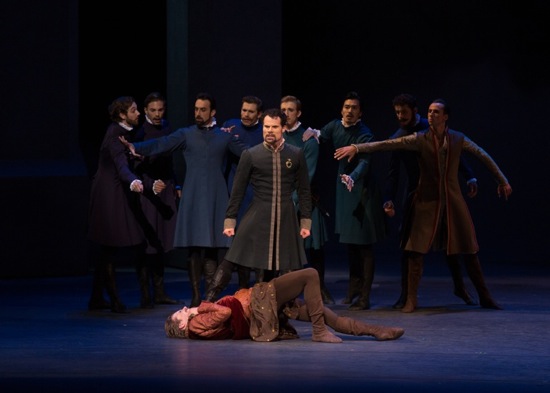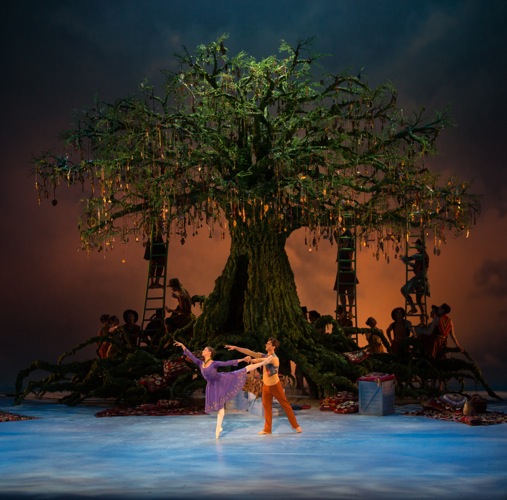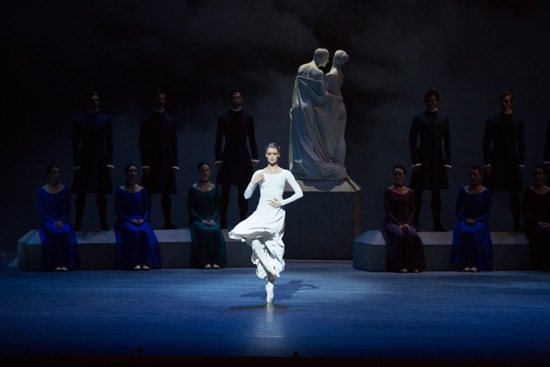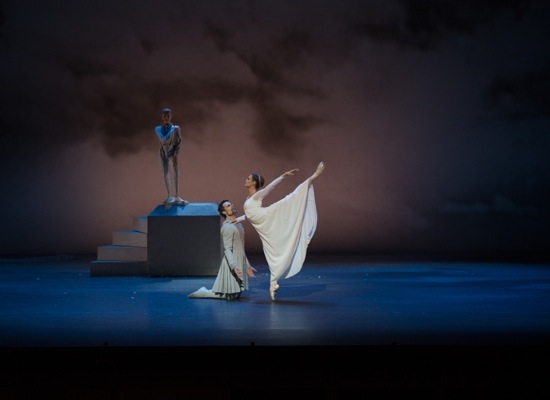
Piotr Stanczyk (Leontes) standing over Harrison James (Polixenes) in Christopher Wheeldon’s The Winter’s Tale. Behind them: Artists of The National Ballet of Canada Photo:Rosalie O’Connor
“What were you thinking, Will?” And “Eat your heart out, Marius Petipa.” These two silent remarks to the eminent dead periodically rattled around in my head while I was at Lincoln Center watching The National Ballet of Canada perform Christopher Wheeldon’s remarkable three-act work based on William Shakespeare’s 1611 play The Winter’s Tale (staged for the NBC by Jacquelin Barrett and Anna Délicia Trévien of Britain’s Royal Ballet, a co-producer of the work).
As was often the case with Shakespeare, he didn’t dream up the plot of the play. It can be traced to Robert Greene’s 1588 prose romance, Pandosto: The Triumph of Time (re-titled Dorastus and Fawnia in 1607). Shakespeare created a new ending, added characters, and recast the tale as a comedy (because everything turned out all right) in the blank verse that he knew better than anyone how to write.
What to make of two kings, friends since childhood, both of whom have such hair-trigger tempers that, on no evidence of wrongdoing on someone’s part, they can erupt into testosterone-fueled rages, during which they brandish knives, knock people to the floor, and order imprisonment and death? What to make of the queen-wife who, presumed dead, is hidden away by her faithful lady-in-waiting for sixteen years, after which she emerges—as if by a miracle—to instantly forgive her husband for attacking and imprisoning her and, in the process causing the death of her little son, who was wasting away from sorrow and from worry about his mother?
In the play’s first act, Leontes, King of Sicilia, asks his wife, Hermione, to invite his guest, Polixenes, King of Bohemia, to stay a few weeks longer; she pleads so charmingly and so convincingly that Leontes immediately suspects that Polixenes must be the father of the child she is carrying and casts her brutally off, even though a just-arrived message from a trustworthy oracle proclaims her innocence and his error. In Act IV, Polixenes (in disguise) sees his son Florizel in the woods, romancing lovely Perdita, presumably the daughter of a well-to-do shepherd (Donald Thom), but unknown to him, the daughter of Leontes, rescued in infancy. When Polixenes asks Florizel to name his father, and the lad refuses, he reveals himself, disowns his son, and says to Perdita, “And thou, fresh piece/ of excellent witchcraft, who of force must know/ The royal fool thou copest with, . . . .I’ll have thy beauty scratched with briars. . . ”
How to feel sympathy for such fellows? In the ballet’s scenario (by Wheeldon and its composer, Joby Talbot), the courtiers and merrymaking peasants may look on horrified or cluster and whisper among themselves, but they take little action. However, absent of words, Wheeldon and the excellent dancers convey Leontes’ outbursts as a dementia born of jealousy that he can’t control, and Polixenes’ briefer fits as the result of seriously hurt feelings. We see their bodies and rhythms transformed by the conflicting emotions that Shakespeare puts into words.

Another cast in Christopher Wheeldon’s The Winter’s Tale, Act II. Elena Lobsanova (Perdita) and Francesco Gabriele Frola (Florizel). Photo: Rosalie O’Connor
This danced The Winter’s Tale might indeed amaze the 19th-century balletmaker Marius Petipa. Instead of fake swans on a painted lake, as in his Swan Lake and a painted panorama on rollers to show Prince Florimund’s search for Princess Aurora in The Sleeping Beauty, Bob Crowley’s set, Natasha Katz’s lighting, Daniel Brodie’s projections, and Basil Twist’s “silk effects” create almost instantaneous changes of scenery. Long flights of wooden stairs and wooden ramps move with agility; tall doorways are equally mobile, as are four life-sized white sculptures depicting relationships in the story (a man and woman embracing, a man groveling like a beast, a man reaching from behind a woman to place a hand on her belly. . .). On the rippling sheet of silk that descends at times, clouds form, waves rise up, ships travel over stormy seas, and, to chase Leontes’ Head of Household, Antigonus, (after he has sadly, but obediently abandoned the infant Perdita on a beach), a tidal wave with ferocious eyes looms up on the fabric to illustrate Shakespeare’s famously enigmatic stage direction: “Exit, pursued by a bear.” For Act II’s Bohemian village festival, a wonder of a huge, three-dimensional tree stands on a rocky hillock, bedecked with shiny strips of paper; Florizel can hide in its trunk to change his princely attire for peasant garb.
Wheeldon has found many ingenious ways to convey plot elements. To begin Act I, two little boys, one in green, one in red (Crowley’s costumes are fine and to the point, not overly ornate), briefly play a game on the floor, to be almost instantly replaced by their color-coded adult selves, Leontes and Polixenes (Piotr Stanszyk and Harrison James in the cast I saw). Hermione (Hannah Fischer) wears a plain blue gown and later a white one, under which you can see her pregnancy grow over the course of Act I. Polixenes lets us know that he’s bidding farewell to his hosts by rushing in, dressed for the road, while servants assemble his boxes and bags at the back of the stage.
A fine touch: David Briskin leads the NBC’s orchestra in Talbot’s excellently dramatic score, but in Act II, five of the musicians, costumed and onstage, complement those in the pit by adding bansuri, dulcimer, accordion, and percussion. Principal flautist Leslie J. Alt opens Act II with a reedy solo melody on the bamboo bansuri, as teen-aged Perdita (Jillian Vanstone) dances prettily alone, and then exuberantly with her equally young and ardent suitor, Florizel (Naoya Ebe), although with classical steps.
The choreography, especially in Act I, reveals characters and relationships through small touches, as well as more expansive movement passages. The adults show their love of Leontes and Hermione’s bright, eager little son, Mamillius (Simon Adamson-de-Luca), and Antigonus’s wife (Xiao Nan Yu)—who believed the oracle’s predictions and is taking care to ensure that they come true— conveys both her devotion to her queen and Mamillius and her strange love for Leontes (after one of his explosions, she cradles his head in her hand as he crouches in front of her). The single gesture that brings on Leontes’ jealous crisis comes after a trio within an ensemble dance (imagined Sicilian style), in which the two kings dance affectionately with Hermione—helping each other to lift and turn her. When it finishes, she faces front, with the two men on either side of her, and suddenly puts both hands on her belly. Leontes and Polixenes, wanting to feel the baby kick, touch her too. Innocent enough, but Polixenes’s gesture ignites fatal suspicion in Leontes.

Hannah Fischer as Hermione dances alone, accused of adultery in Act I of The Winter’s Tale. Photo: Rosalie O’Connor
Wheeldon shows this husband’s rapidly increasing anger as a kind of madness that attacks and deforms his courtly stance. When he beats one foot against his other ankle in ballet’s frappé, the move is almost sinister. He crouches and slithers, frames his head between his hands like a jaw. His fingers creep up his body like spiders ready to infiltrate his brain. As Stanczyk so convincingly plays him, he becomes truly monstrous. Hermione, after giving birth and having had her baby taken from her, dances both unsteadily and stiffly, as if her own body were betraying her; going down the line of watching court ladies, she contracts over each, perhaps re-experiencing childbirth. She rises on point over and over, with one leg in an arabesque behind her, marking time (but, alas, amid all the finely delineated expressiveness, she manages that well-known supported move that I term “the anguished pirourette”).
I’m impressed by some of the unexpected touches: applause, cries of approval, laughter, clapping, and so on that burst from the dancers occasionally. When Florizel kneels to Perdita, they all say, “Ahh!” in affectionate approval. Those communing with one another often move their lips to simulate conversation. The acting, throughout, is wonderfully convincing, even when the two leading men go into their rages.
The most dancing occurs in the initially festive Act II. The country folk dance lustily, shaking their shoulders in a sort of invented Bavarian folk dance, with music to suit. Florizel shows off his leaps. The shepherd’s son (Dylan Tedaldi) and a lively shepherdess (Jordana Daumec) lead the revels. Women sit in a row and pat the floor in rhythm while the men show off. But eventually, Polixenes has his fit, attacking Perdita and her adopted father, who, with the lovers, immediately flees to Sicilia (at the helm of a three-dimensional ship in front of the projected waves and flying seabirds). Seconds later, another ship appears: Polixenes and his steward (Giorgio Galli) in pursuit.
That ends Act II. In Act III, Perdita and Florizel are graciously received in Sicilia by the mourning Leontes in a wintry setting (he believes, gladly, that Florizel is his father’s envoy, and that a reconciliation is to come; he blesses the lovers). Soon Polyxenes arrives in Sicilia in another violent rage (the courtiers avert their faces). But a royal necklace found with the abandoned baby and now around Perdita’s neck explains all. Icy crags frame a blue sea. Couples wearing white dance. The ice is breaking, snowflakes fall, the statues are unveiled, the onstage musicians join, and the lovers exchange vows.

The Winter’s Tale, Act III. The penitent Leontes (Piotr Stanczyk) and the resurrected Hermione (Hannah Fischer). Photo: Rosalie O’Connor
But, wait, there’s more happiness to come. Paulina is ready to reveal her secret, but she has arranged its discovery very theatrically. She leads the principal players in this drama to a place that contains a new statue—one of Hermione and little Mamillius, yet to be unveiled. Off comes the cloth. Silence. Awe. How beautiful! How lifelike! Leontes touches her gently. She moves! She separates herself from the statue of her little son, and after she is off the plinth, Leontes curls around her feet in penitence and adoration. Poised in a beautiful arabesque, she forgives him.
Then comes another of Wheeldon’s wonderfully expressive ideas. Perhaps she wants him to remember the past and what she suffered unjustly, so she teaches him some of the gestures and movements that appeared earlier, as she helps him to regain strength.
Paulina suffers, feeling herself alone now that both families are reconciled, and expresses that by winging her arms in angry, distorted ways, above her bent body. In the play, Leontes sees to it that she, widowed, marries one of his lords. I don’t think I saw that happen in the ballet. Perhaps Wheeldon was promoting an irony; she saved Hermione for Leontes, which means she herself must give him up.
It’s marvel that in this two-and-a-half hour, two-intermission ballet, Wheeldon, his collaborators, and the splendid performers kept me engrossed most of the time in the somewhat preposterous and messy story (Shakespeare was 47 in 1611, when it was possibly first presented; he died five years later). I admire how sensitively and economically his play was translated into ballet, how imaginatively it was mounted, and how beautifully it was presented.

Hey, there’s a lot of passive voice in that last graph! That aside, I continue to be awestruck at your breadth of knowledge about the contexts of what you’re writing about — (or that about which you’re writing!) You rock!
And if I may say so, you don’t rock in the least passively! Wish I could see this; your post is the next best thing.